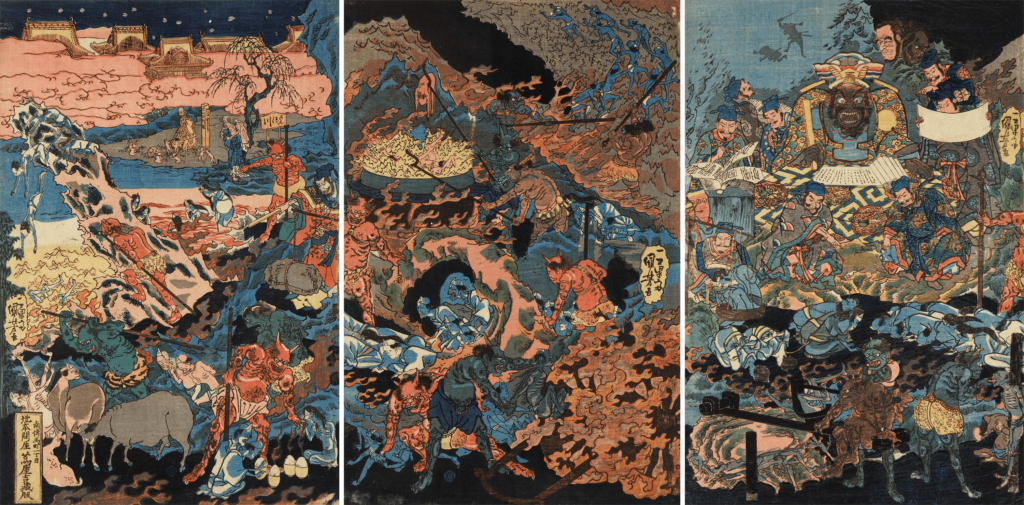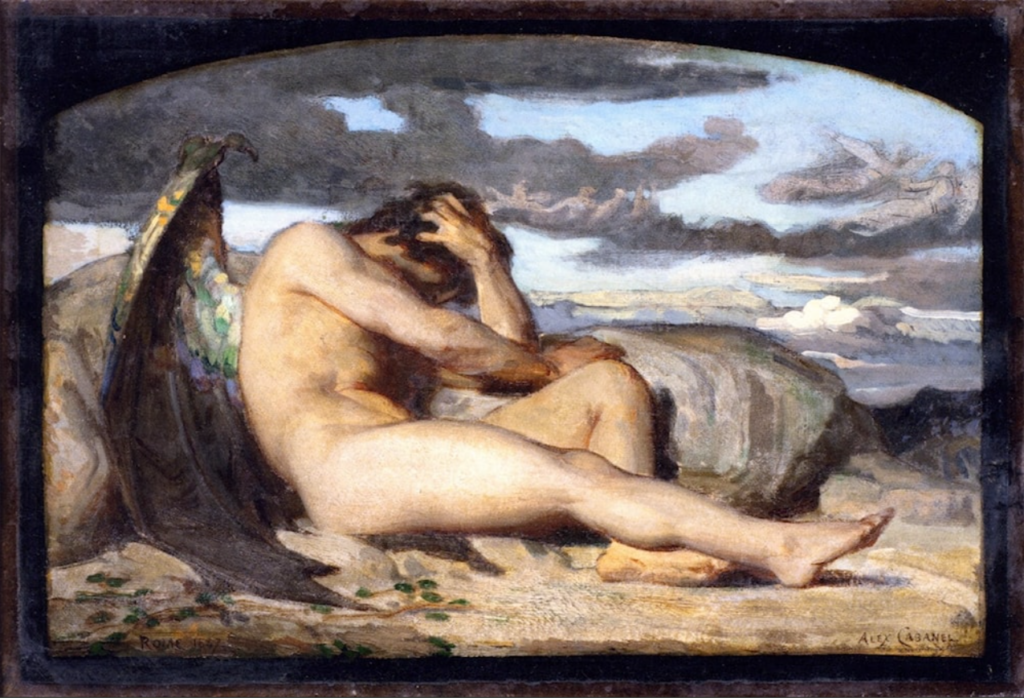Marian Henel—Tapestries and Madness
Marian Henel’s tapestries are huge. The largest one measures over 6 m in length and 3 m in width (19 ft. 8 in. by 9 ft. 10 in.). Created in the...
Zuzanna Stańska 25 November 2024
Paintings of Satan are a recurrent theme in art, ranging from religious portrayals to contemporary interpretations. As the symbolic representation of evil in religious contexts, Satan takes on diverse forms, from a beautiful angel to the most menacing beast, across various global religions. This article delves into lesser-known paintings of Satan, offering a perspective you may not have encountered. From his inaugural depiction in art to representations in different religious contexts, let’s explore the unsettling aspects that contribute to the terror associated with the Dark Lord!

Paintings of Satan: Parable of Sheep and Goats, 520 AD, mosaic. Basilica di Sant’Apollinare Nuovo, Ravenna, Italy.
In the Basilica of Sant’Apollinare Nuovo in Ravenna, Italy, rests a remarkably ancient mosaic dating back to 520 CE. This Byzantine masterpiece illustrates the parable of sheep and goats from the Gospel of Matthew.
At the mosaic’s center stands a beardless Jesus, a characteristic portrayal from the early Christian era. To his right stands an angel adorned in red attire and with crimson wings, likely representing Archangel Michael. At Jesus’ feet are sheep, symbolizing the souls destined for the Kingdom of Heaven according to the parable.
On Jesus’ right side appears another angel, draped in blue attire with wings of the same hue. At his feet, goats are depicted, symbolizing the condemned souls destined for the Underworld. This blue angel is thought to be Lucifer. According to Jeffrey Burton Russel in his book “Lucifer: The Devil in the Middle Ages,” the portrayal of Satan as a goat-beast emerged much later in the Middle Ages, drawing inspiration from the ancient god Pan.
This mosaic thus stands as a compelling candidate for the oldest depiction of Satan in art.

Paintings of Satan: Roberto Ferri, Lucifero, 2013. Artist’s website.
Roberto Ferri, an Italian contemporary artist, frequently draws comparisons to Caravaggio due to his style and overall technique, mirroring aspects of the renowned Baroque painter. Although Ferri’s subjects draw inspiration from religious or mythological themes, aligning them with Academic art, he transcends convention by infusing elements of eroticism, passion, and torture. Ferri’s oeuvre, if labeled, could be aptly described as Contemporary Baroque, a term yet to be officially coined.
A striking example of Ferri’s distinctive approach is found in “Lucifero,” presenting an idealized portrayal of the archetypal angel. Possessing robust wings, curly hair, and exquisite facial and body features, Lucifero is depicted seated on a stone, akin to Prometheus in Guillaume Geefs’ Le Génie du Mal. However, Ferri introduces a unique twist—Lucifero’s foot bears the marks of gangrene. In contrast to Geefs’ defeated depiction, Ferri’s Lucifer exudes an air of nobility and pride, defying the conventional portrayal of a fallen angel.

Paintings of Satan: Utagawa Kuniyoshi, Ghosts, Devils, and The King of Hell, 1850, woodblock print, The British Museum, London, UK.
This beautiful artwork is a woodblock print in the genre of ukiyo-e of the Edo period in Japan. Its artist, Utagawa Kuniyoshi is known for his wide variety of subjects, imaginative compositions, and the expert use of color and linework. The painting under discussion shows a complex scene with ghosts, demons, devils, all sorts of evil creatures, and of course, the King of Hell.
According to Japanese Buddhist mythology, the King of Hell is Emma-ō and rules the kingdom of Hell (Jigoku). He judges the souls of men, whereas his sister judges the souls of women. The sinner is then sent to one of the 16 regions of fire and ice in Jigoku. They stay there either until the next rebirth or until they are saved by the prayers of the living. If the prayers save them, they are reborn on Earth or in Paradise. Emma-ō is usually portrayed with a ferocious expression on his face, wearing a judge’s cap, and holding a mace of office.

Paintings of Satan: Iblis the Demon, from Kitāb al-mawālīd (‘The Book of Nativities’), 7th century AH/13th century CE. Paris, Bibliothèque nationale de France, Arabe 2583, folio 2r. Müller und Schindler.
Another interesting interpretation of Satan is by the Islamic religion. According to the Quran, God ordered all the angels, including Iblis, to bow before Adam, the newly created human. However, Iblis refused to bow claiming he was stronger than Adam because he was made of fire, while Adam was made of clay. Thus, God banished him from Paradise and sent him to Jahannam, the hell.
While the Quran shoes Iblis as a fallen angel, verse 18:50, describes him as a jinn. Certainly, this explains his fire nature. Yet, the scholars and theologians who study the Quran have not come to an agreement yet as to the true nature of Iblis.

Alexandre Cabanel, The Fallen Angel (study), 1846. Oil On canvas. Musée Duplessis, Valcourt, Canada.
Alexandre Cabanel needs no introduction. He is one of the most acknowledged painters of Academic painting and his artworks are among the most famous. One of these is The Fallen Angel, which Cabanel created in 1847. However, in this case, we will examine the study he made one year earlier.
Cabanel proved his talent at a young age. Yet his paintings did not gain the approval of the art world, or the Salon, at first. As an artist of his time, he was influenced by religious and mythological themes. In 1846, Cabanel created a large painting, portraying a nude athletic Orestes, son of Agamemnon, based on the Greek drama. The Salon disapproved of his effort, leaving him resentful and disappointed.
The same year, he painted the study of The Fallen Angel. The painting shows Lucifer, hiding his head in his arms, in despair. It is right after God banished him from Heaven and right before his descent to Hell. The environment is gloomy and filled with dark clouds. Some critics find that Cabanel painted himself, after the disapproval of the academy. The study is different from the painting he made in 1847, where Lucifer is still in despair, shedding a tear, but his expression shows wrath and rage. His body is muscular and all the muscles are in tension, as if he is ready to stand up and create chaos.
DailyArt Magazine needs your support. Every contribution, however big or small, is very valuable for our future. Thanks to it, we will be able to sustain and grow the Magazine. Thank you for your help!